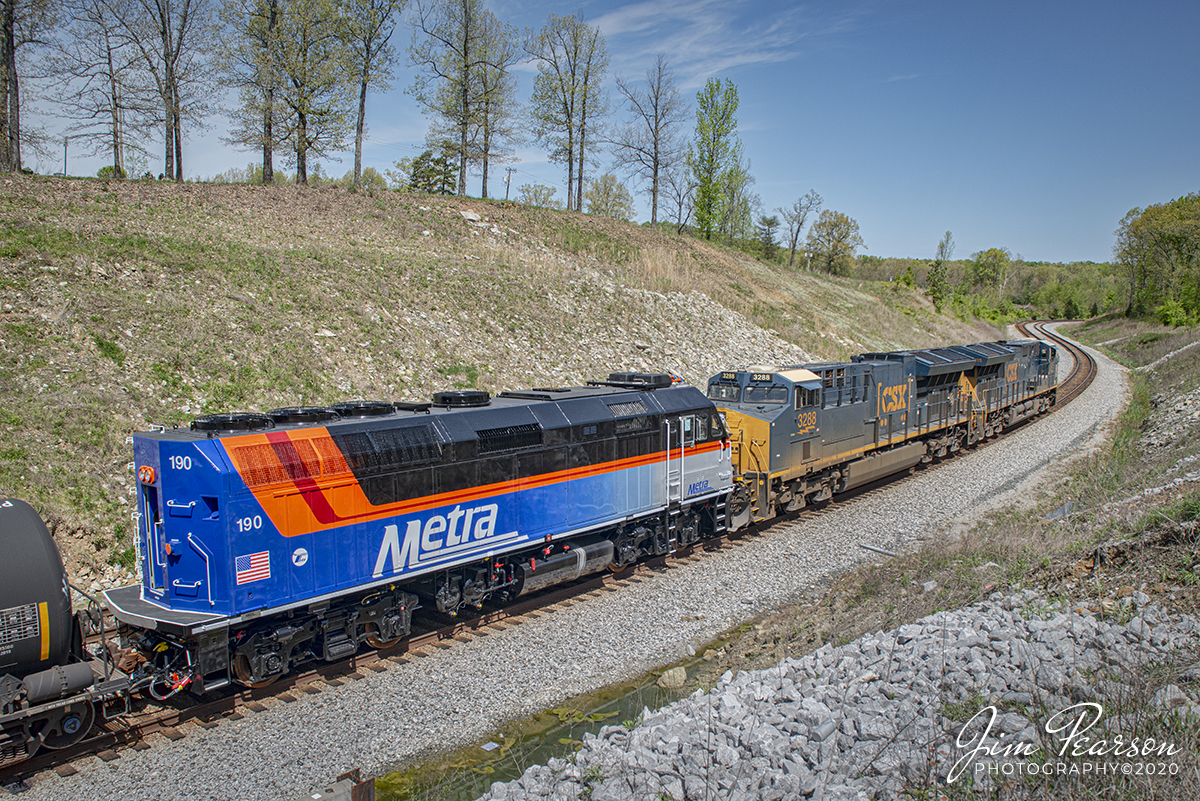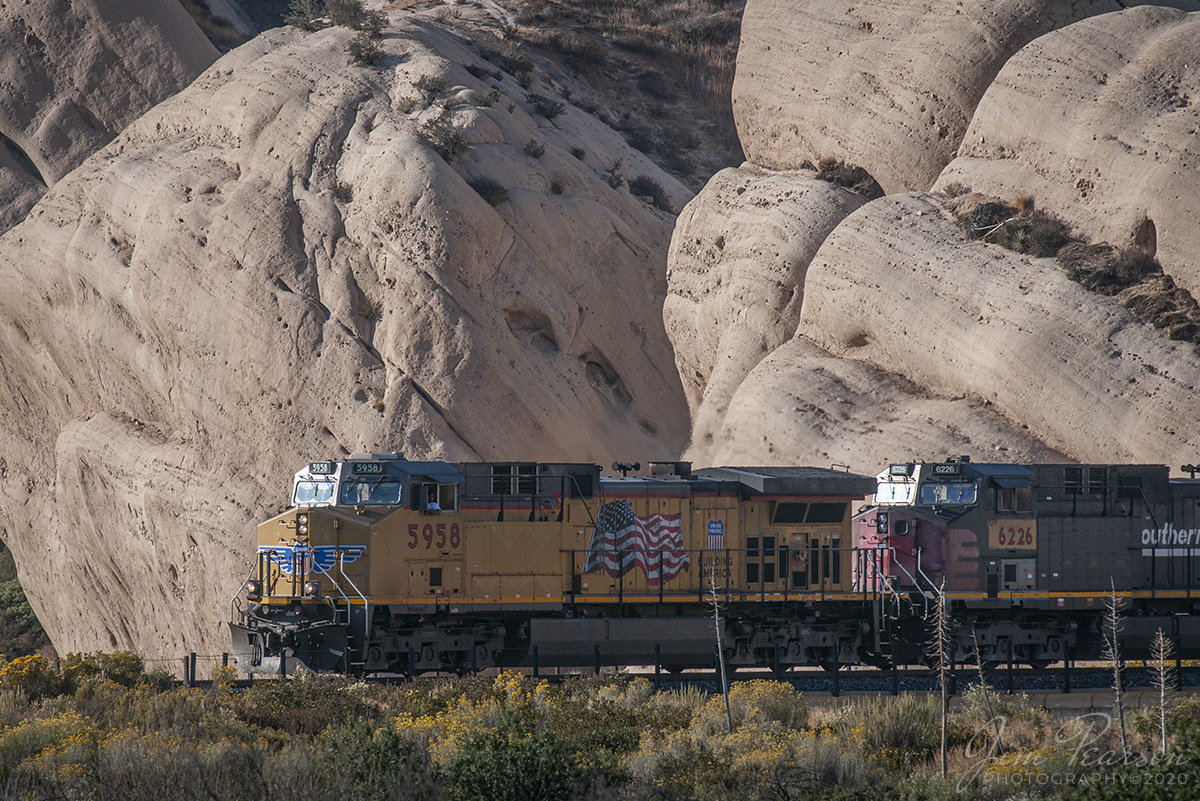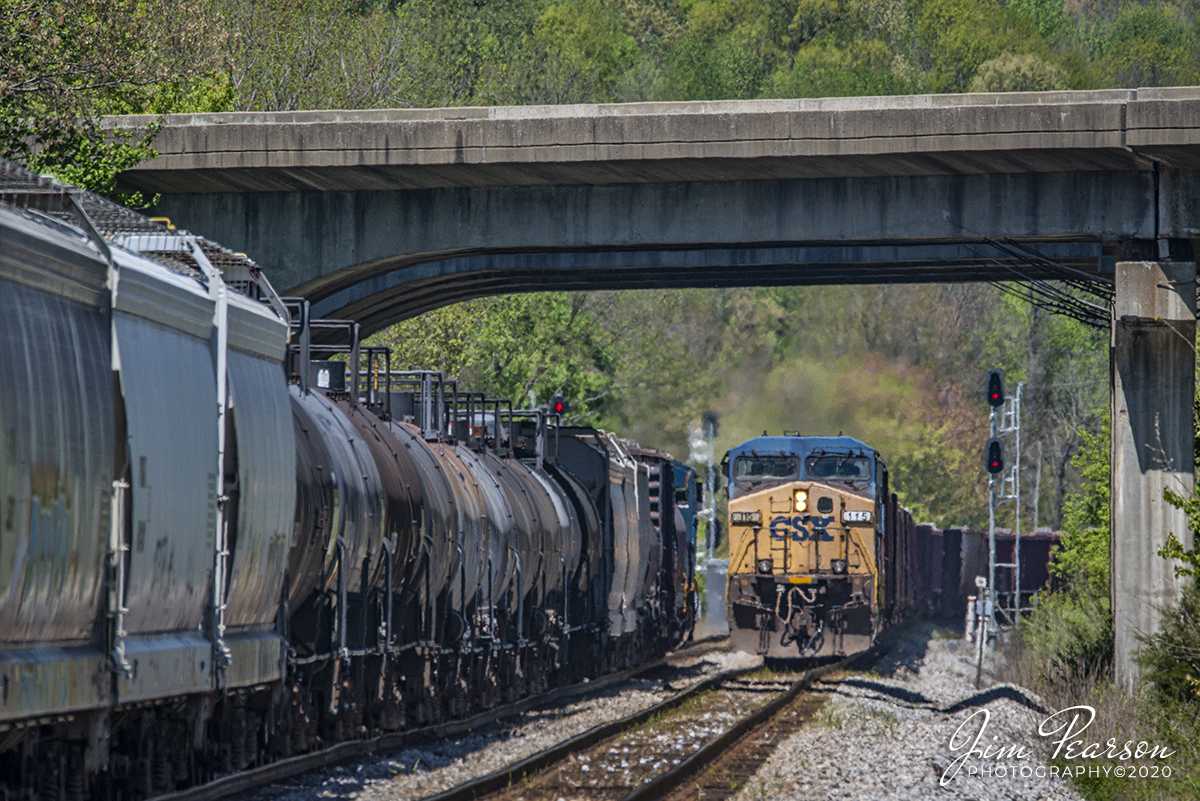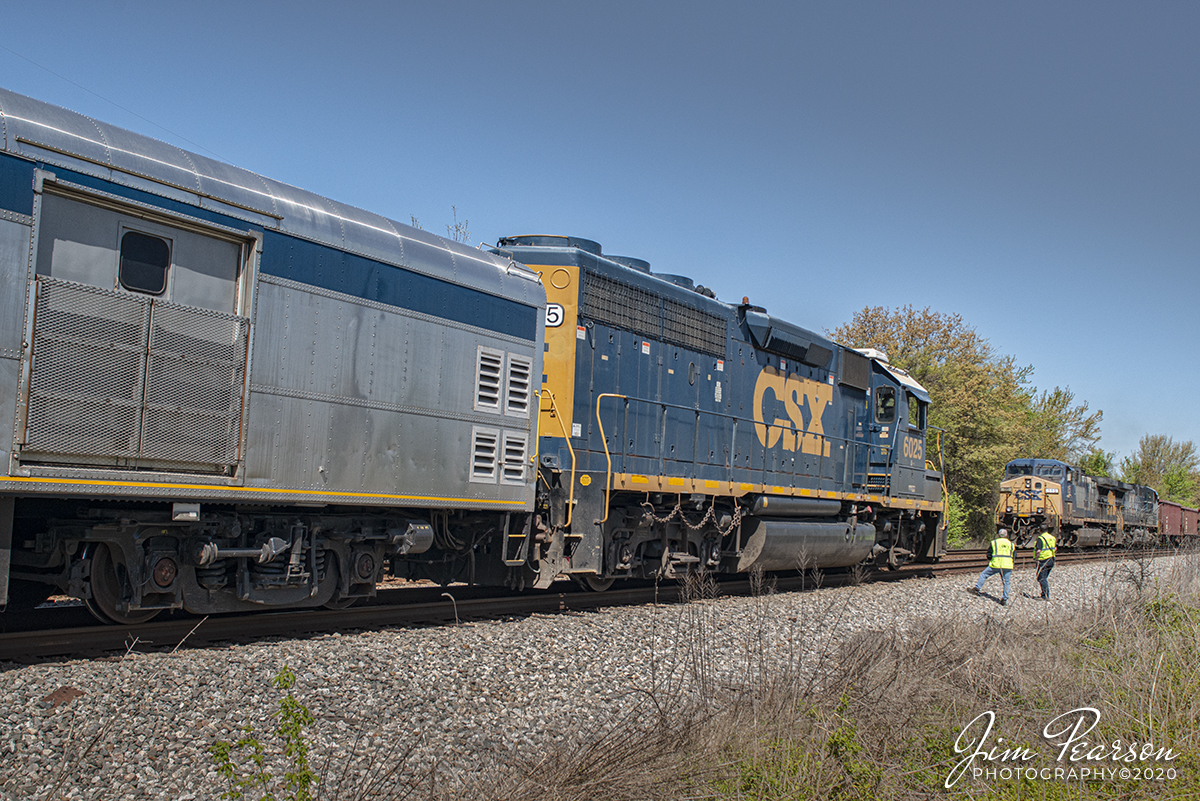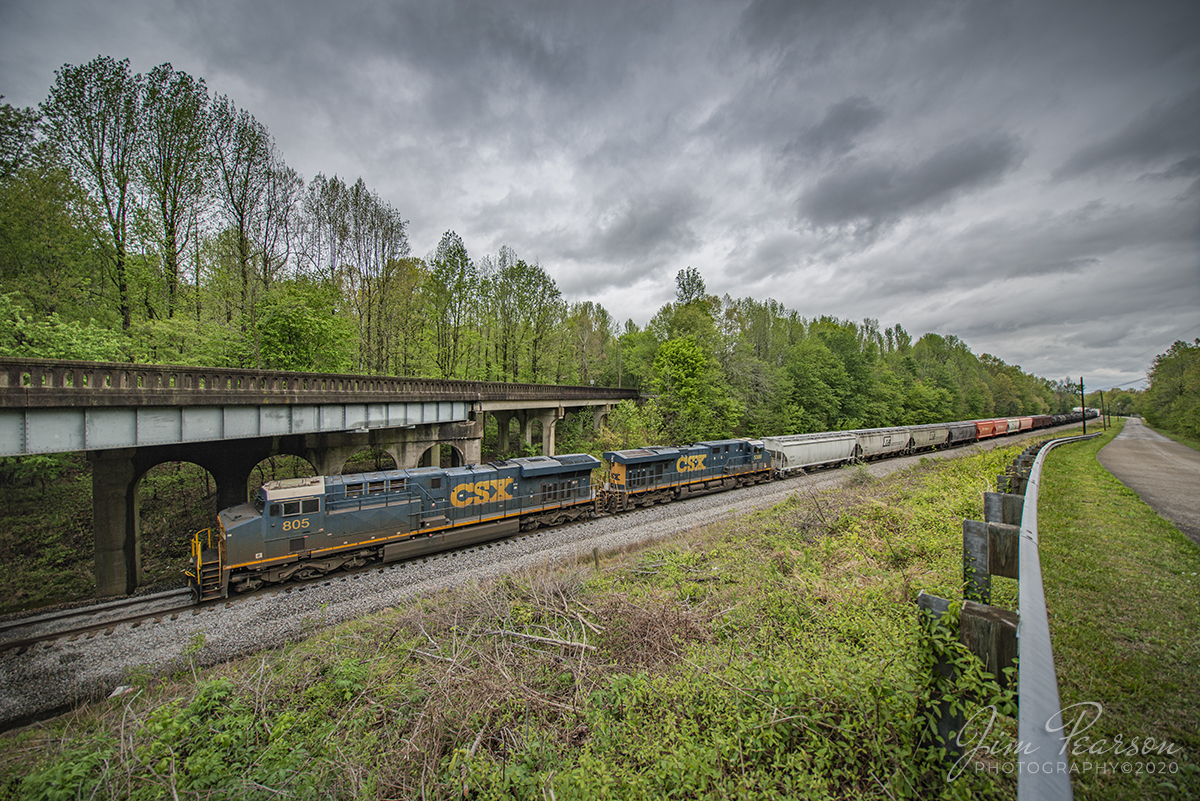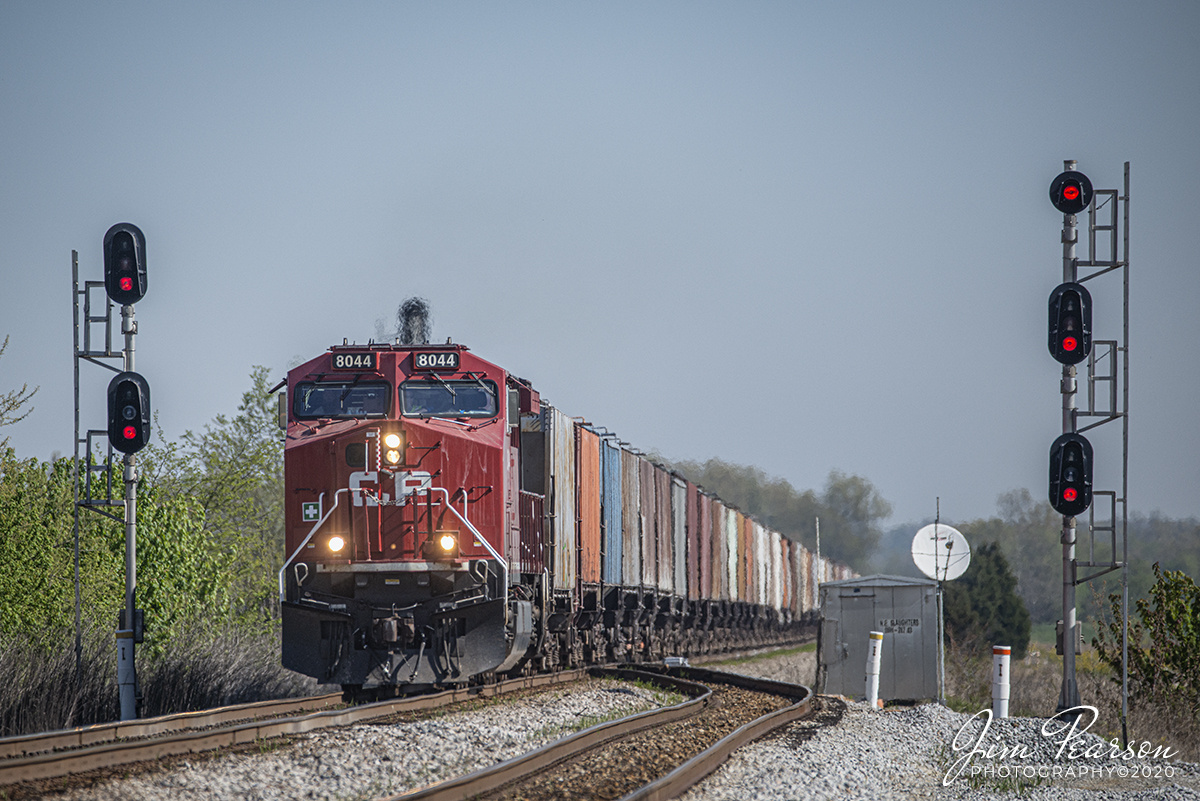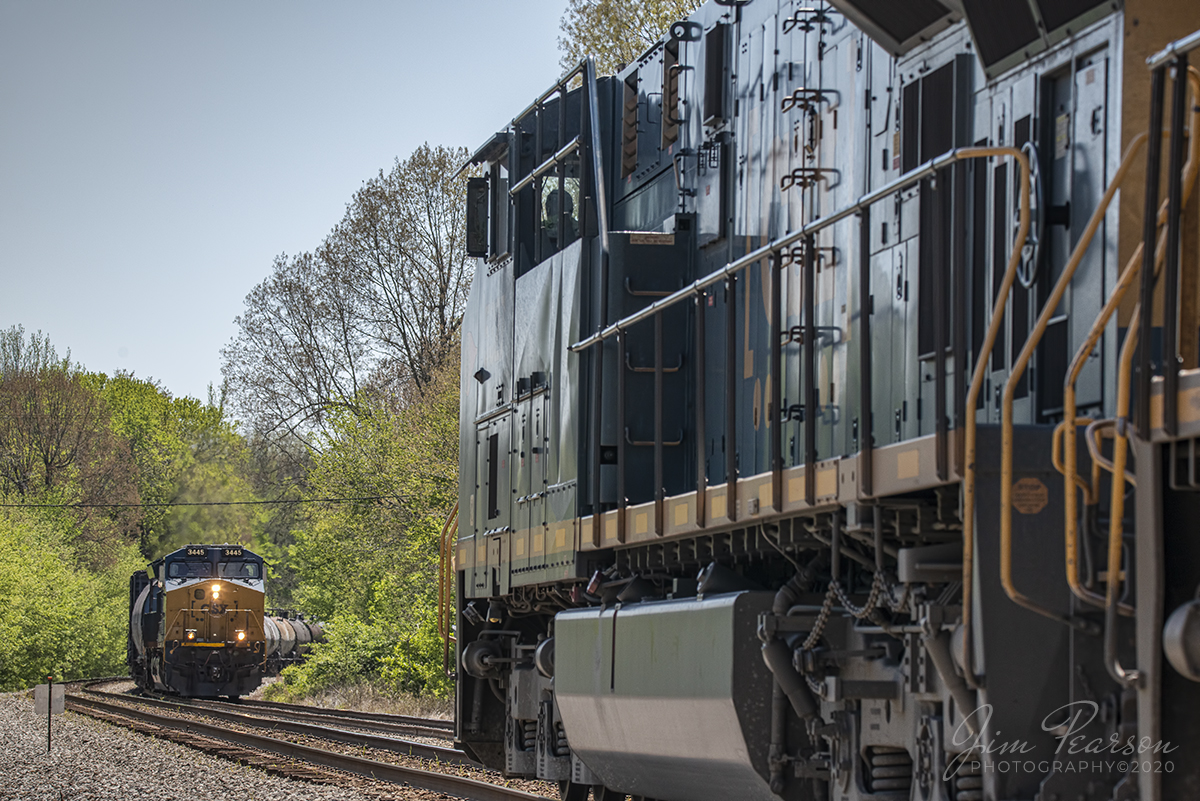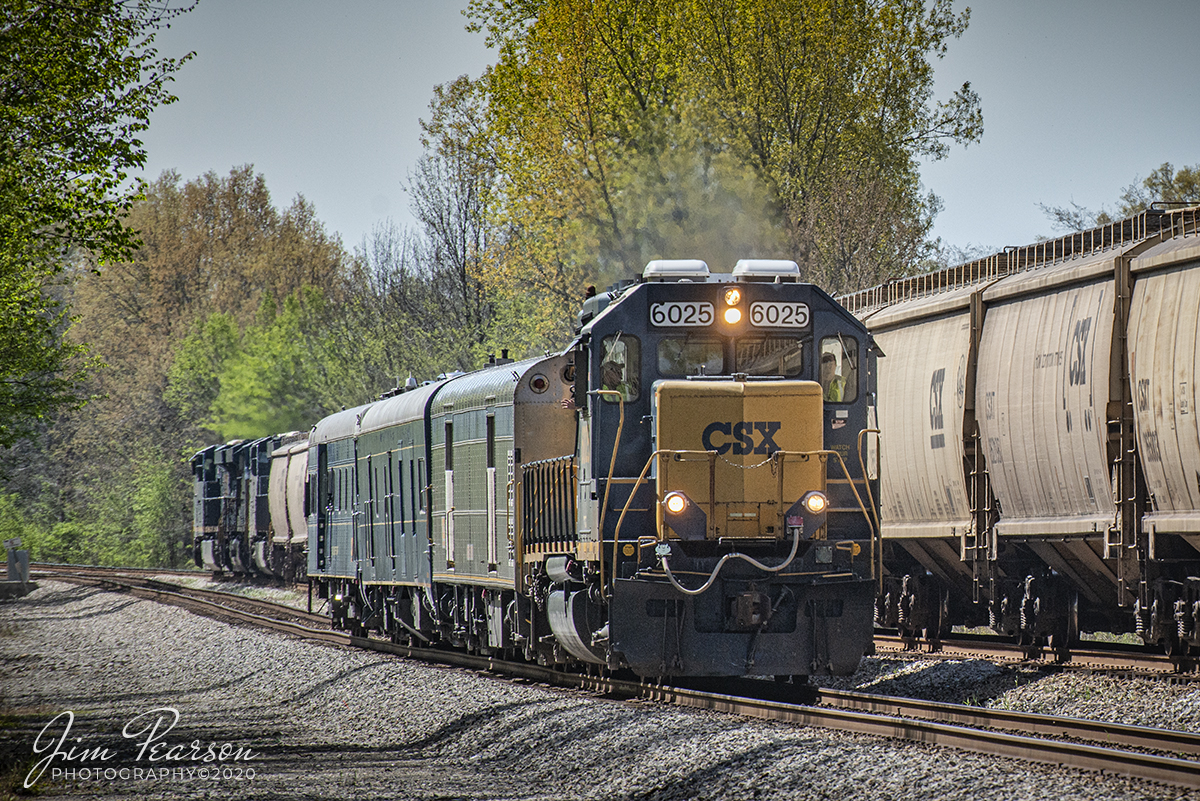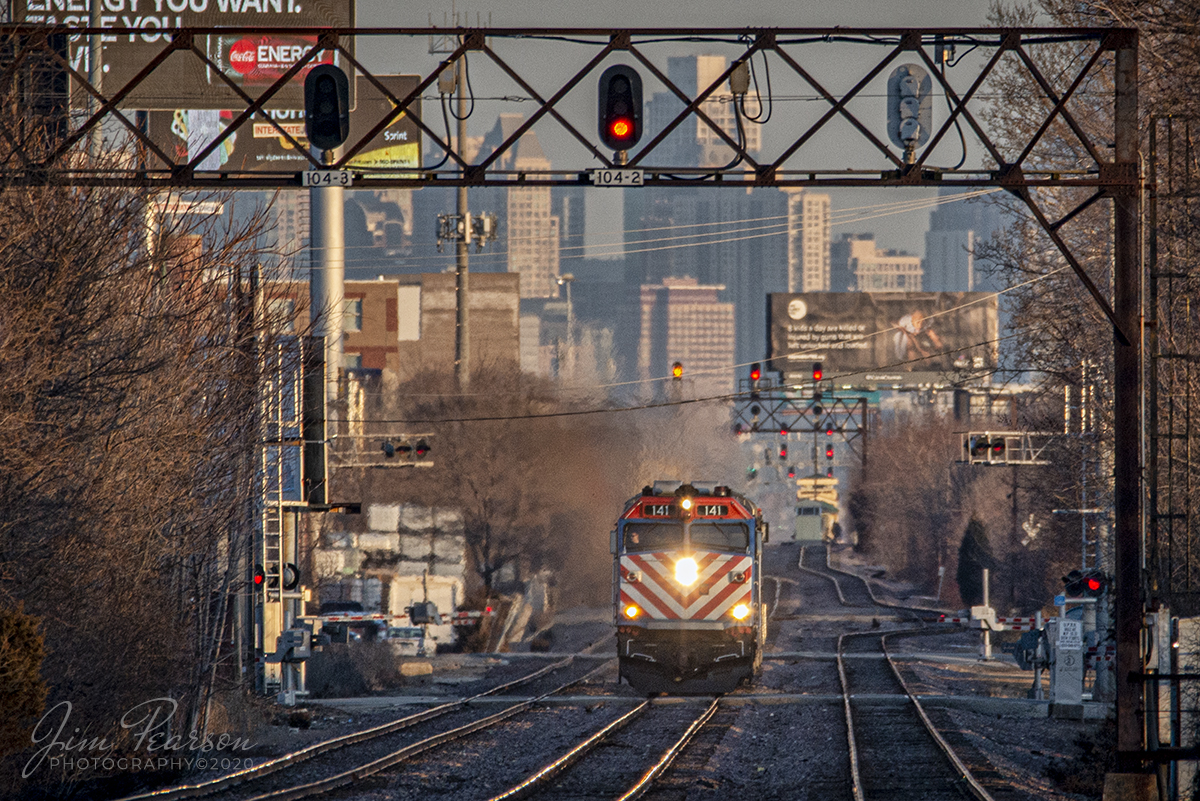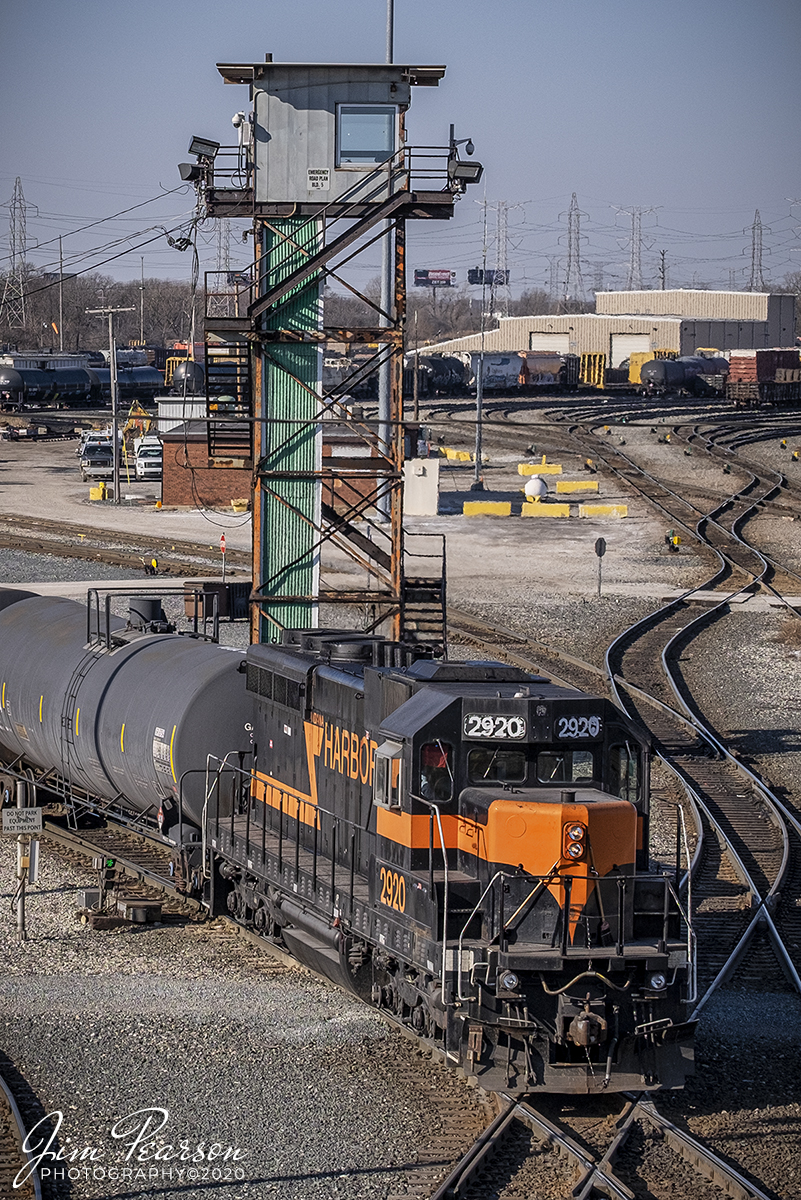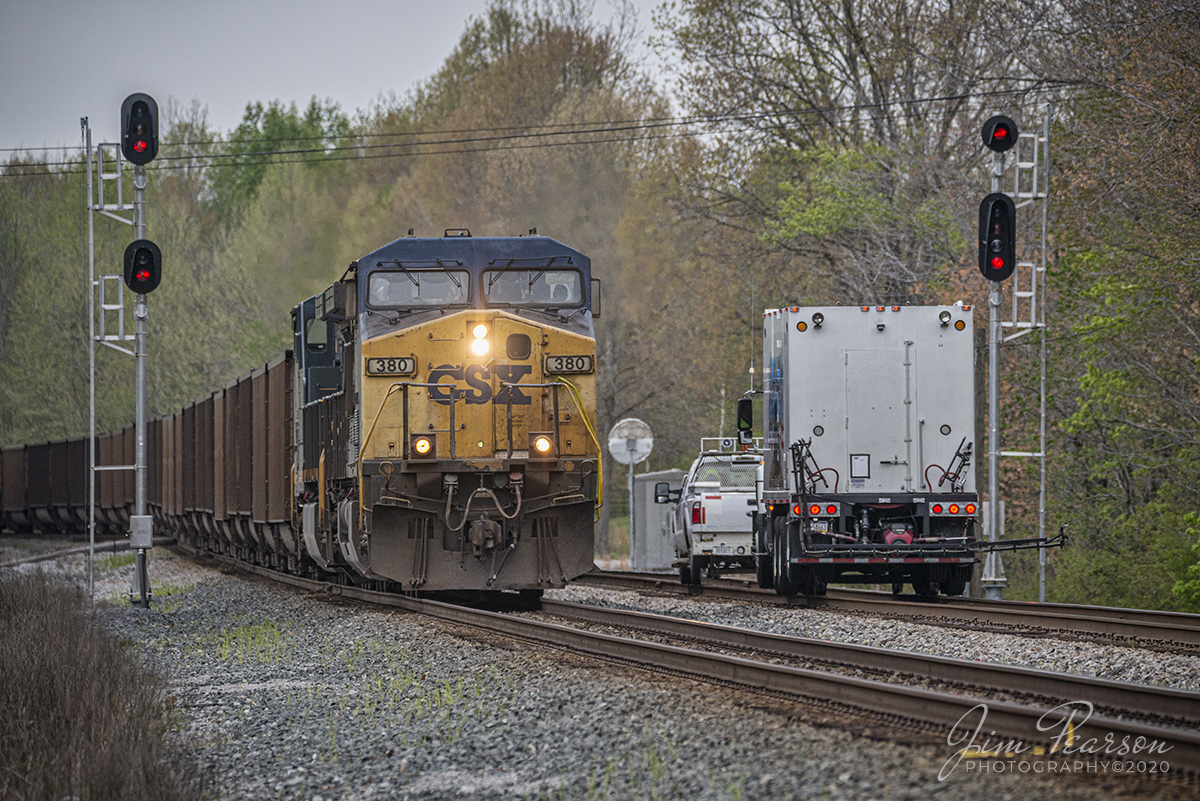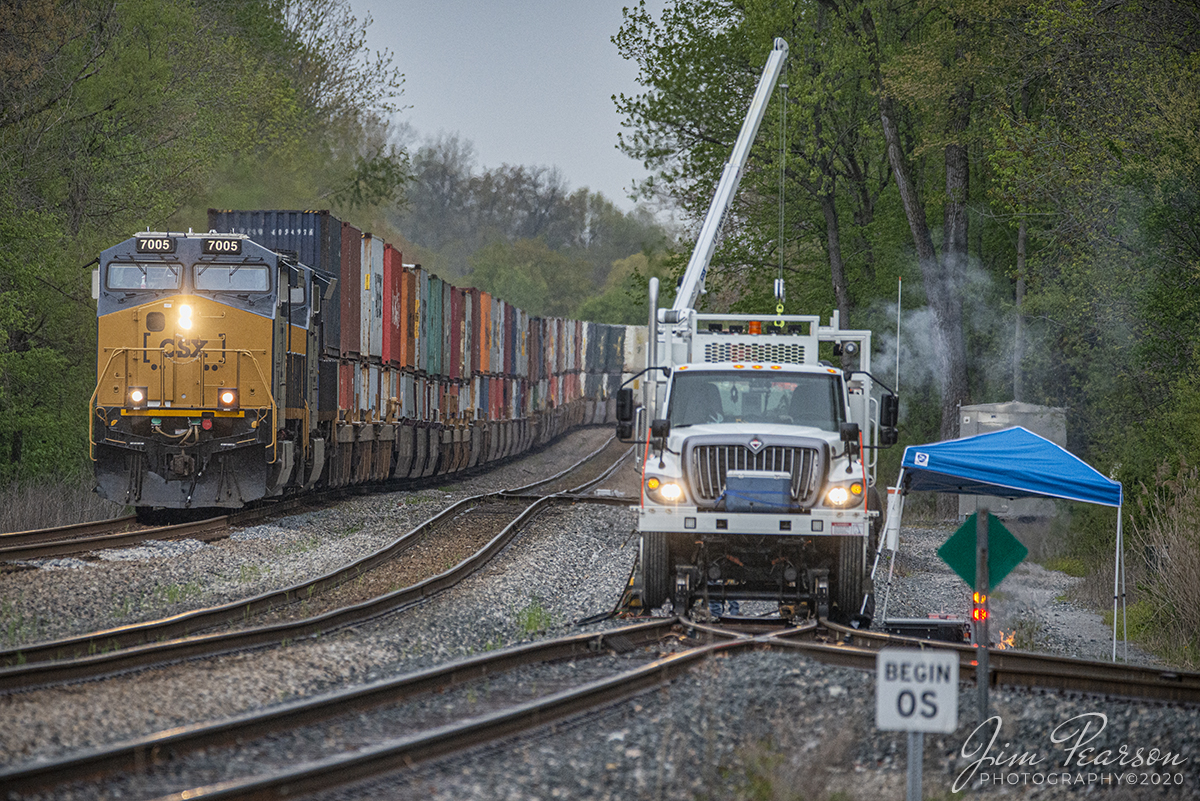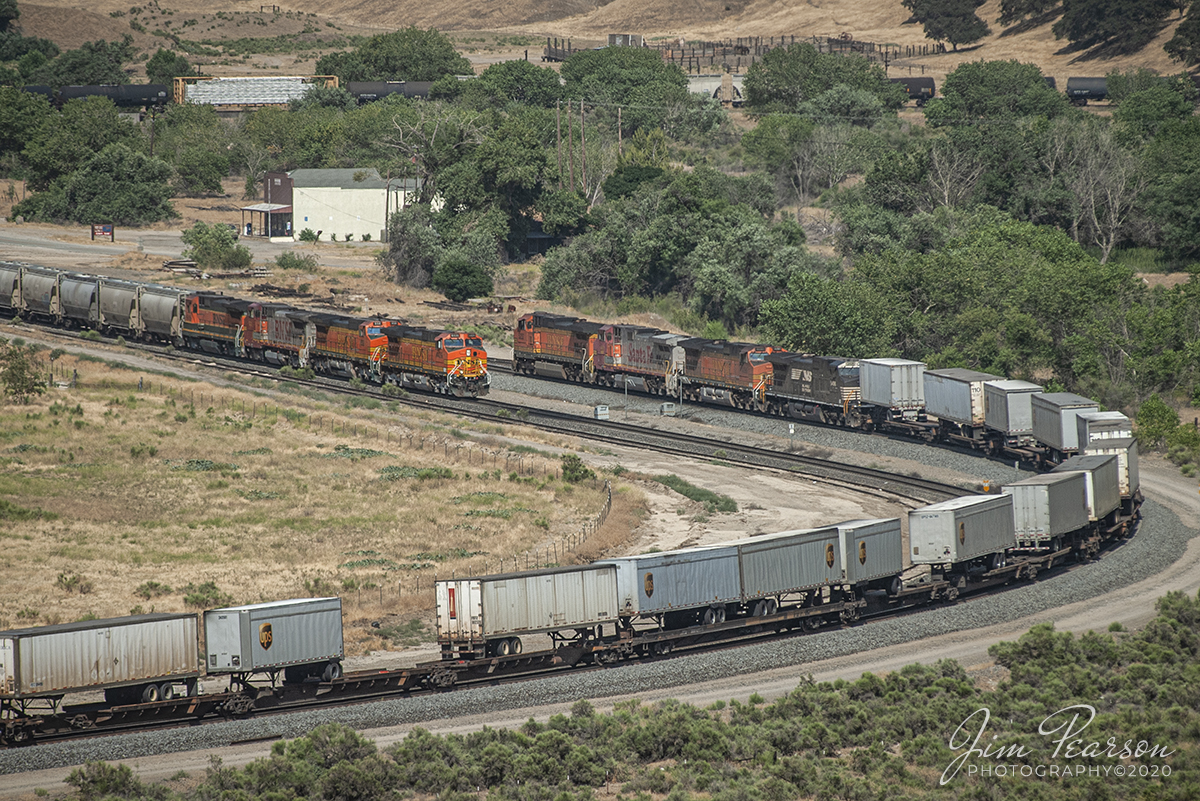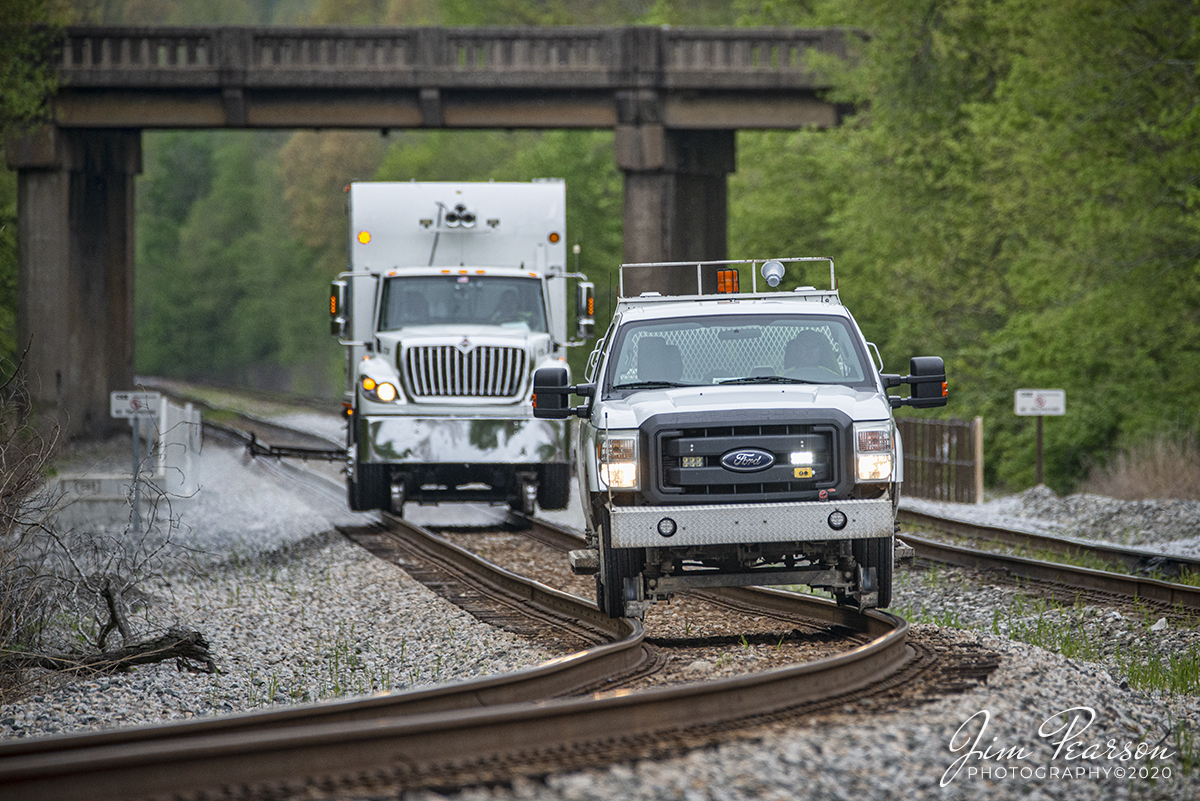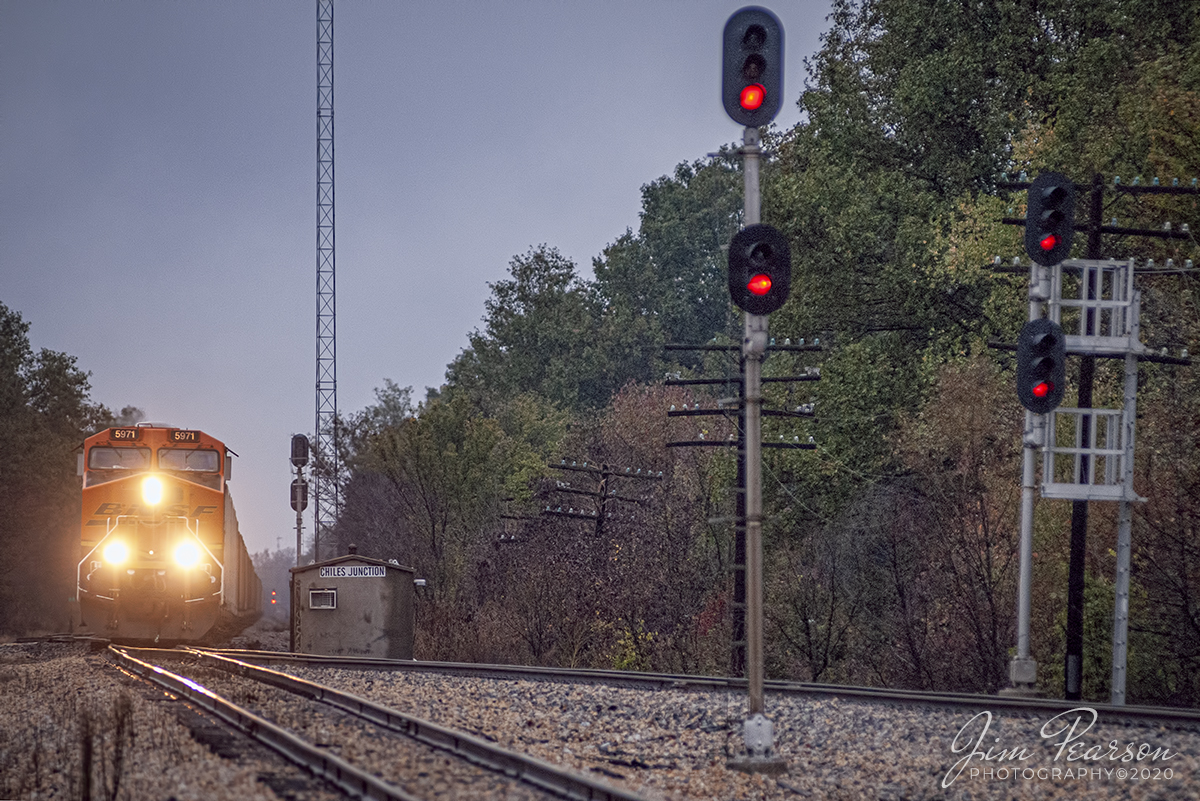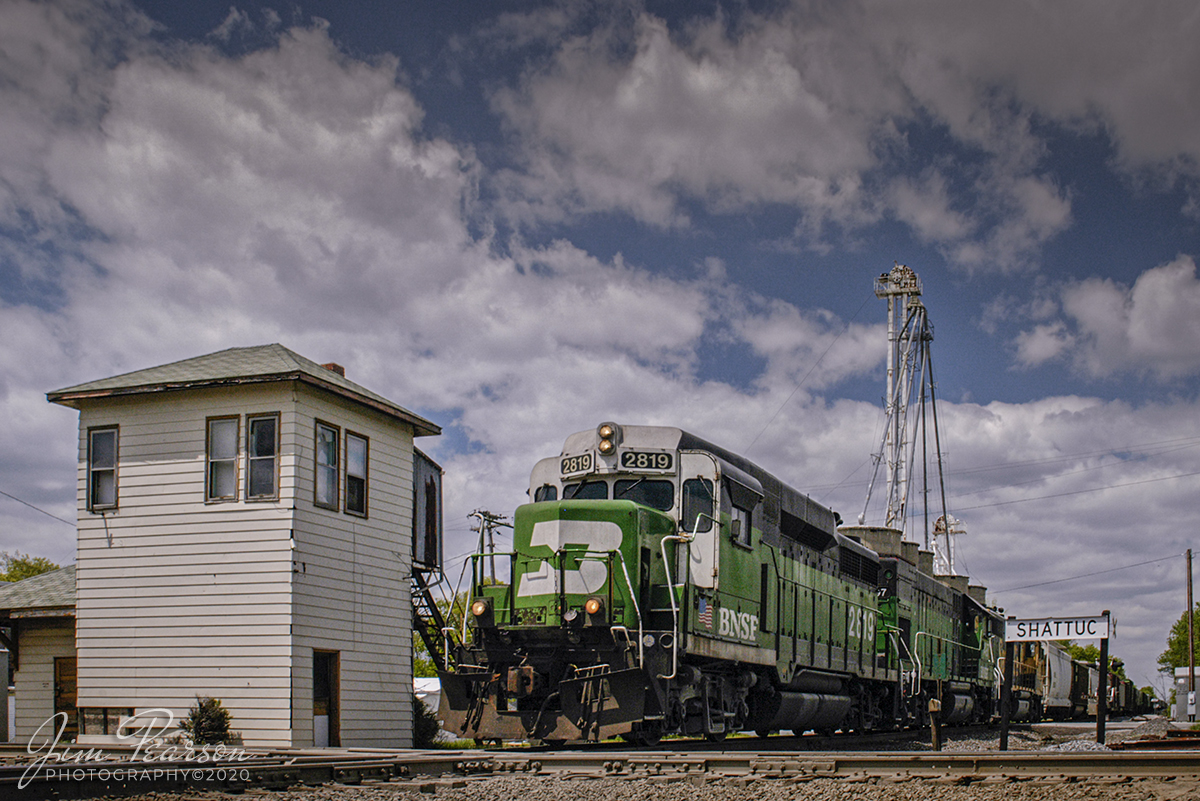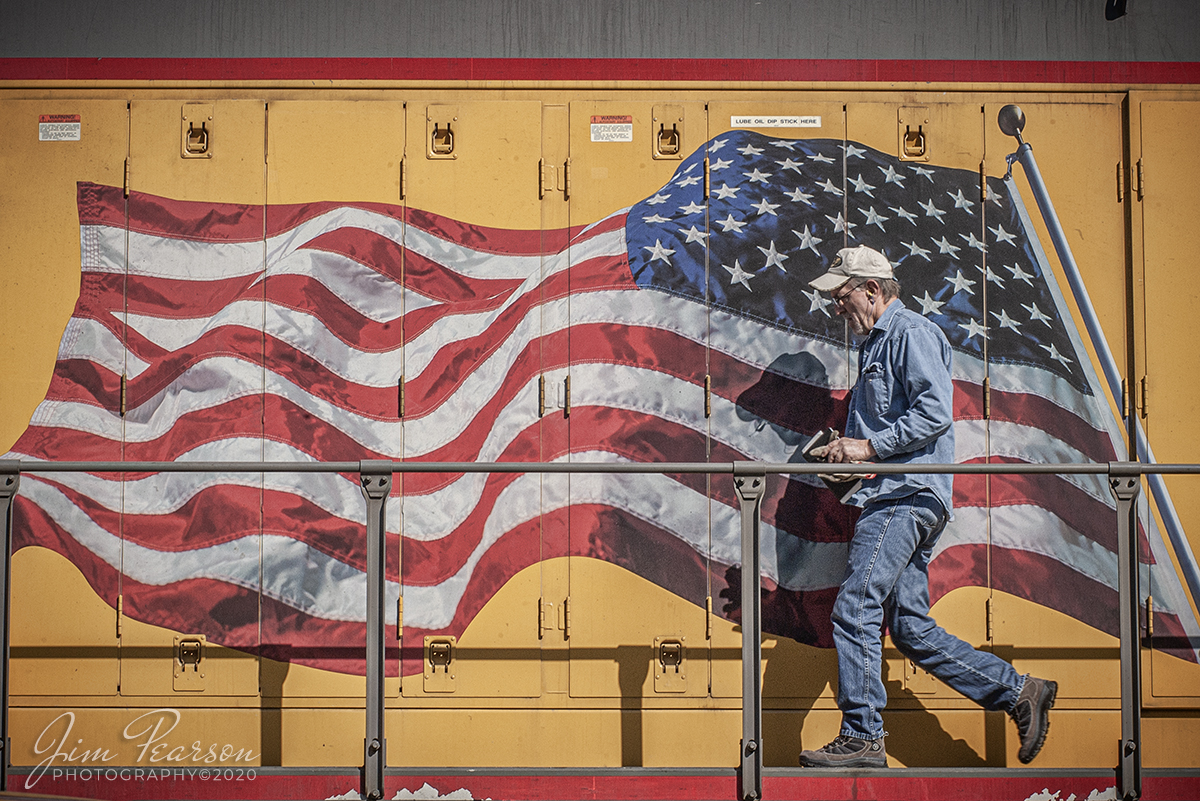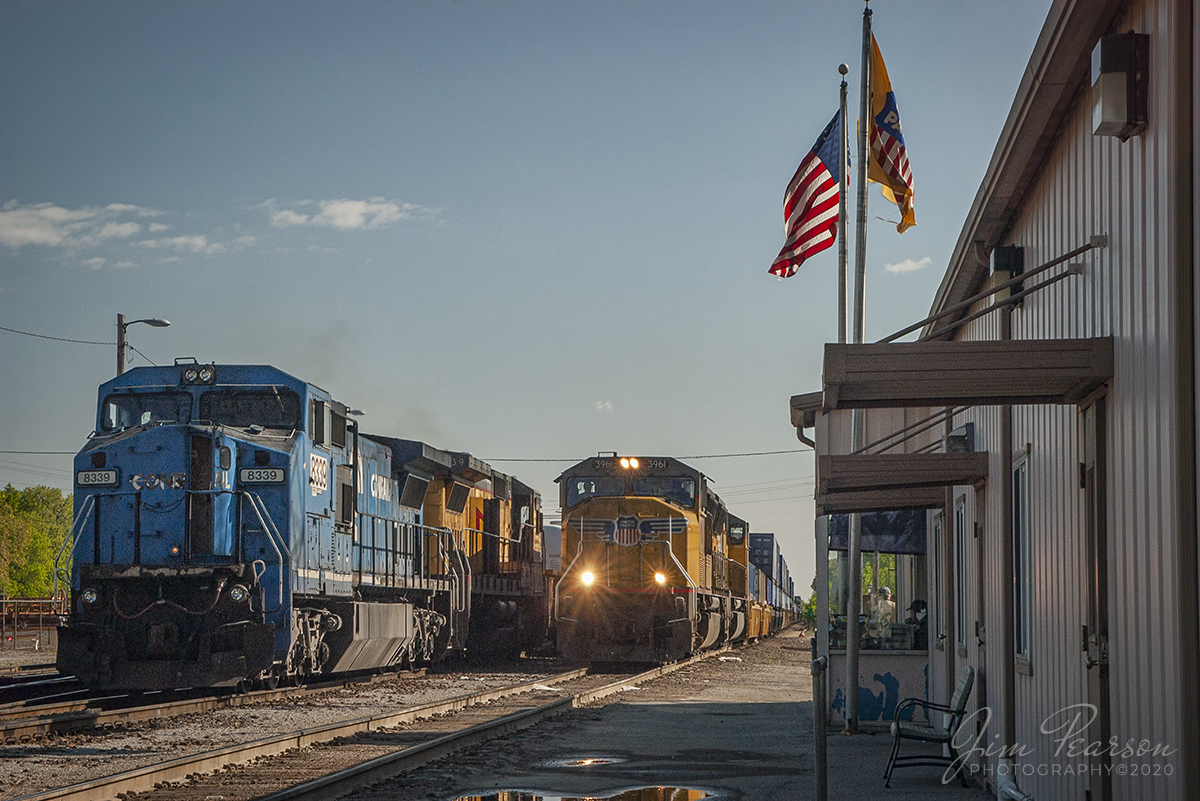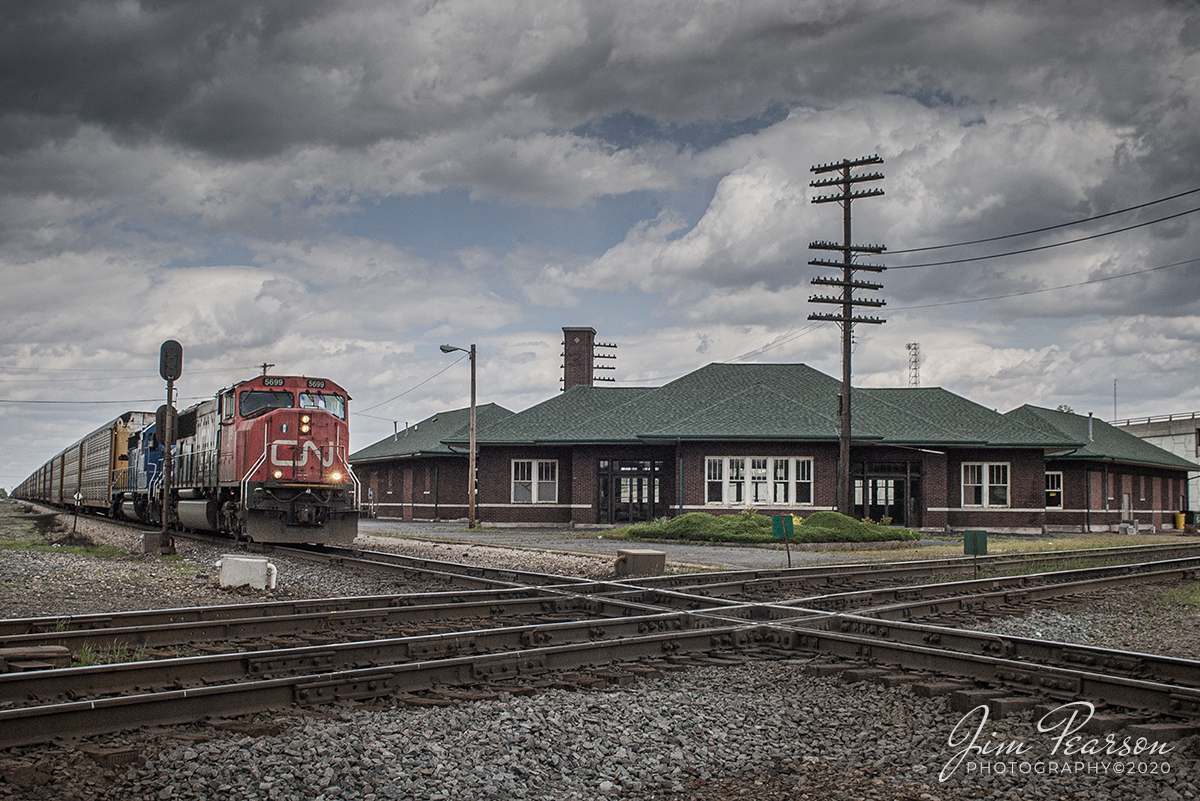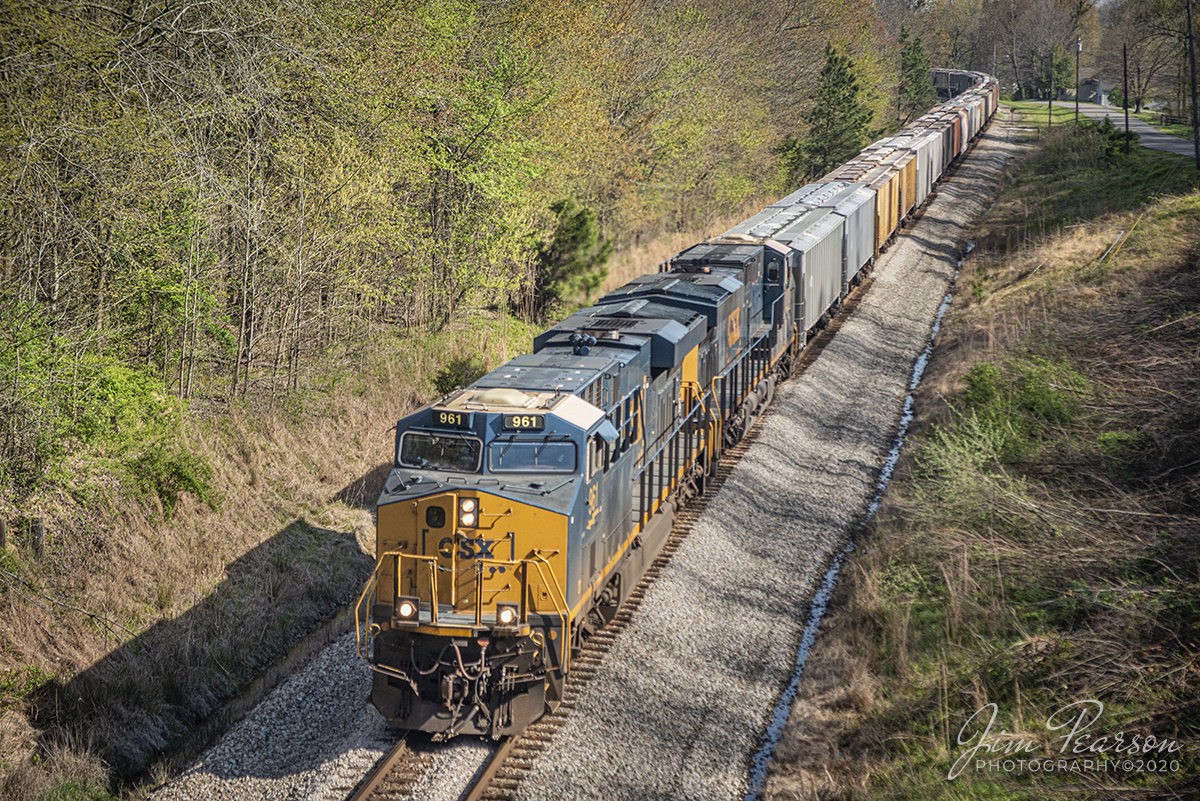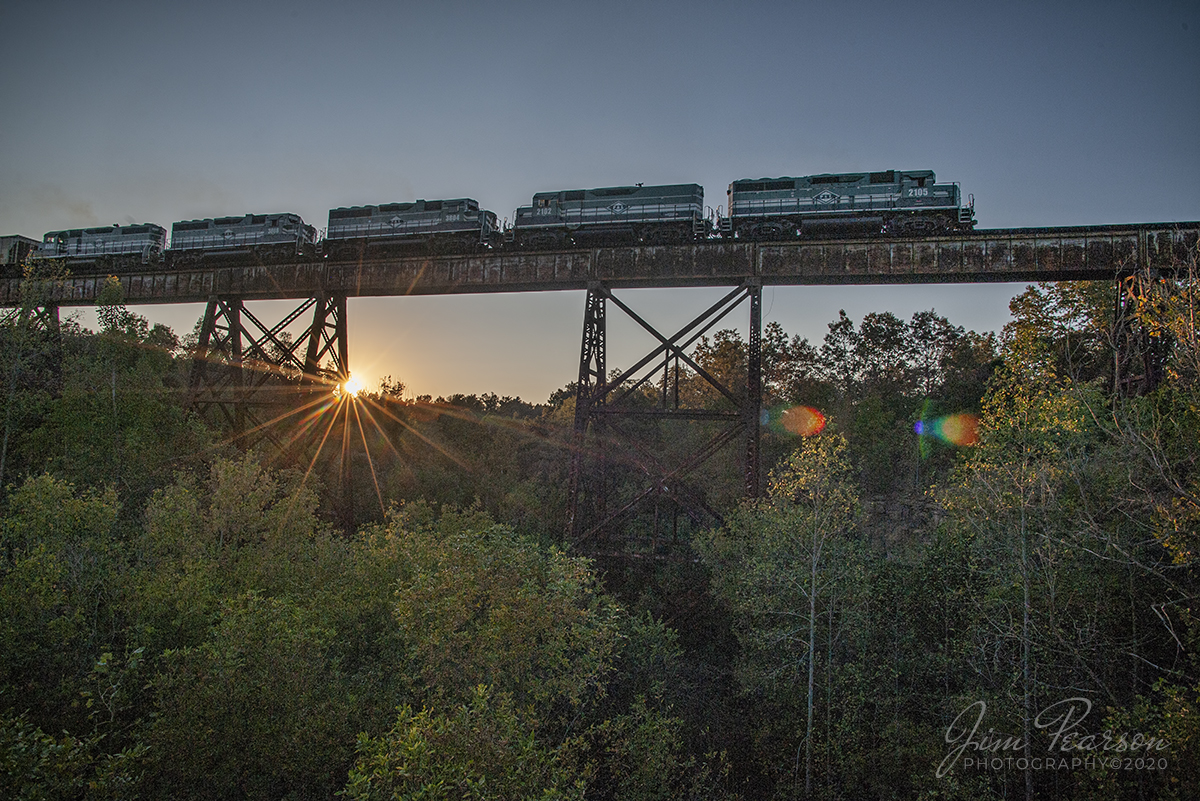April 27, 2020 – Newly rebuilt and repainted Metra locomotive 190 runs as the trailing unit on CSX Q648 as it passes through the S curve on main two at Nortonville, Ky as it heads north on the Henderson Subdivision on its way to Chicago, Illinois.
The late evening light rakes across the base of Mormon Rocks…
October 20, 2008 – The late evening light rakes across the base of Mormon Rocks as UP 5958 and 6266 (ex-Southern Pacific Unit) lead a west bound freight down the Cajon Pass in southern California.
Local legend has it that the rocks were named for the Mormon pioneers who camped here after their descent from the pass ridgeline. Another legend calls the rocks the ‘Chanting Rocks,’ as when the wind would blow across the portholes in the rocks it was said the sound made was similar to a low chanting or singing.
CSX empty ballast train W086 takes the siding at Oak Hill…
April 20, 2020 – CSX empty ballast train W086 takes the siding at Oak Hill as it passes a northbound CSX 502-20 on the main as the ballast train makes heads under the I-69 overpass on its way south on the Henderson Subdivision.
The crew on CSX Geometry inspection train W001…
April 20, 2020 – The crew on CSX Geometry inspection train W001 conducts a roll-by inspection ballast train W086 at the north end of Robards Siding as it heads south on the Henderson Subdivision at Robards, Kentucky.
CSX Q503 heads south at the Hwy 41 overpass at Mortons Gap, Kentucky
April 23, 2020 – CSXT 805 and 5386 head up CSX Q503 as it heads south at the Hwy 41 overpass at Mortons Gap, Kentucky on the Henderson Subdivision under stormy skies.
Canadian Pacific 8044 leads an empty phosphate train…
April 20, 2020 – Canadian Pacific 8044 leads an empty phosphate train past the north end of the siding at Slaughters, Kentucky as it heads south on the Henderson Subdivision.
CSX G217 meets Q502 at Oak Hill, Little Valley, Ky
April 20, 2020 – The engineer on loaded grain CSX train G217, keeps his eyes on the track ahead at Oak Hill, between Mortons Gap and Nortonville, Ky, as his train meets Q502 as they both make their way along the Henderson Subdivision.
Geometry Inspection train W001-20 at Robards, Ky
April 20, 2020 – CSXT G213 passes CSXT 6025 heading up Geometry Inspection train W001-20 as they inspect track two, just south of Anaconda at Robards, Kentucky on the Henderson Subdivision.
On the rear of the trains is the actual track geometry car (also known as a track recording car) which is an automated track inspection vehicle.
It used to test several geometric parameters of the track without obstructing normal railroad operations. Some of the parameters generally measured include position, curvature, alignment of the track, smoothness, and the cross level of the two rails.
It uses a variety of sensors, measuring systems, and data management systems to create a profile of the track being inspected.
Metra engine 141 heads up an evening commuter train…
February 21, 2020 – Metra engine 141 heads up an evening commuter train as it heads out of Chicago, Illinois toward Norwood Park Station as the late evening light rakes across the downtown skyline.
Indiana Harbor Belt (IHB) 2920 at Riverdale, IL
February 22, 2020 – Indiana Harbor Belt (IHB) 2920 (SD20 backs into the Blue Island Rail Yard at Riverdale, Illinois, past the old control tower, as it works on building a train. From what I find online the unit was built in 1959 and was rebuilt by Illinois Central in 1980 from IC 2010. Then it went to NRE in 2/95, and was leased to IHB 9/96, before being purchased by IHB 6/2007.
According to the IHB Website: The Indiana Harbor Belt Railroad is the largest switch carrier in the U.S. with 54 miles of mainline track (24 miles of which is double main track) and 266 miles of additional yard and siding track.
The IHB provides a wide variety of services, including industrial switching with 160 customers, generating 170,000 carloads of business annually. The IHB interchanges daily with 16 other rail carriers in Chicago. A growing fleet of approximately 1,400 freight cars is geared predominately to the steel industry. The industrial traffic base includes 4 of the 5 largest steel producers in the U.S. and a large aluminum processor, oil refineries, corn millers, grain elevators, chemical plants, warehouses, lumber transloading, and bulk transfer operations. IHB’s industrial traffic consists of 38% primary metals, 12% chemicals & petroleum products, 11% food products, 8% scrap iron, 7% coal & coke, 6% whole grain, as well as a variety of other products including lumber, paper, and aggregates. The IHB also operates as an intermediate switch carrier between the 12 trunk-line railroads for traffic interchanged between them in Chicago, generating an additional 475,000 revenue cars.
The IHB main line circles Chicago from near O’Hare to Northwest Indiana and roughly parallels Interstate 294 (Tri-state Expressway) and I-80/94. Its primary yard, Blue Island (a 44 class track hump yard) at Riverdale, IL lies in about the center of the railroad. Other major yards includes Gibson (in Hammond, IN) which only classifies cars of new autos and Michigan Avenue Yard (in East Chicago) which serves the extensive steel plants which accounts for IHB’s primary business. From East Chicago, the IHB operates east for an additional 16 miles on trackage rights to access Burns Harbor, IN and Portage, IN, which includes Indiana’s International Port.
CSXT 380 leads empty coal train E013-13 NB at Romney…
April 14, 2020 – CSXT 380 leads empty coal train E013-13 as it passes a weed sprayer crew at CP Romney as it heads north on the Henderson Subdivision at Mannington, Ky.
CSXT 7005 leads Q025-17 past a crew working…
April 17, 2020 – CSXT 7005 leads Q025-17 past a crew working on a switch at Anaconda, south of Robards, Ky as it heads south on the Henderson Subdivision with a stack train.
In case you’re wondering about the “Begin OS sign,” from what I find on the web it is an old time term used by telegraph operators and train dispatchers to indicate that a train has passed a particular location on a subdivision. “OS” means “on sheet” referring to the fact that the train dispatcher has recorded train movement on the train sheet he maintained each 24 hour period. It also means Originating Station, the first station on each subdivision from which a train is authorized to occupy the main track.
It was a hot, dry day as a Piggyback with BNSF 5232 leading…
June 23, 2006 – Blast From The Past – It was a hot, dry day as a Piggyback with BNSF 5232 leading headed east, meeting a Mixed freight headed up by BNSF 4438 waiting to head west toward Bakersfield, in horseshoe curve in the valley at Caliente, California as they made their way through the Tehachapi Mountains on the UP Mojave Subdivision.
A CSX High Railer leads a weed sprayer truck…
April 14, 2020 – A CSX High Railer leads a weed sprayer truck just past the highway 62 overpass on track 1, as it sprays the right-of-way at Nortonville, Ky, as the pair make their way south on the Henderson Subdivision, while performing their springtime work.
BNSF 5971 leads a loaded coal train off the Buford Subdivision…
October 22, 2007 – Blast From The Past – BNSF 5971 leads a loaded coal train off the Buford Subdivision at Chiles Junction in West Paducah, Kentucky as it prepares to head down the Paducah and Louisville Railway bound for the coal Terminal at Calvert City, Kentucky.
BNSF 2819 heads past the old interlocking tower at Shattuc, Illinois
May 1, 2005 – Blast From The Past – BNSF 2819 heads past the old interlocking tower at Shattuc, Illinois on BNSF’s Beardstown Subdivision as it crosses over the Illinois Subdivision.
From what I gather from the web, CSX closed the Illinois Subdivision through here at one point and used it for car storage, but then I find references to the line being used now by The Prairie Line, a shortline out of O’Fallon, IL (I’m now told the shortline hasn’t materialized yet). BNSF still owns and uses the Bardstown Sub. I’m also told that the diamond was removed in 2019, at least temporarily.
In the past this tower controlled the movements of trains on the Chicago, Burlington, and Quincy railroad along with the B&O Railroad. It was closed sometime in the 1980’s and from what I can find on the web it was torn down in late 2014. I’ve also found reports where it was bought by a collector and moved. Whichever is correct, this picture isn’t to be replicated again today since the tower is now gone.
If you’d like to read a great piece on the tower, check out this article on The Trackside Photographer by Tom Gatermann, who visited the tower the same year as me.
http://thetracksidephotographer.com/tag/shattuc-tower/
Photograph the towers when and where you can as they continue to disappear from the railroad landscape.
The conductor on a Union Pacific freight walks past the American Flag…
May 1, 2005 – Blast From The Past – The conductor on a Union Pacific freight walks past the American Flag on his engine in the yard at Salem, Illinois.
According to the Union Pacific Website: When we added the flag to our locomotives more than a decade ago – at the suggestion of an employee after 9/11 – we followed the tradition of having the Union (the blue field of stars) lead the way, such that on the right-hand side of the vehicle (“passenger side”), the flag would appear reversed.
Further, the flag was painted to convey the motion of forward movement as if it were billowing with the speed of the locomotive. Having the Union forward on both sides is the overwhelming choice anytime the flag is portrayed on a transport vehicle, from NASA space shuttles to Air Force One.
Union Pacific 3961 pulls to a stop at the UP yard office in Salem, Illinois
May 1, 2005 – Blast From The Past – Union Pacific 3961 pulls to a stop at the UP yard office in Salem, Illinois, with its intermodal train, on the Salem Subdivision as a loaded manifest with ex-Conrail 8339 leading waits for it to pass.
CN 5699 leads a southbound autorack south past the depot at Effingham, Illinois
May 1, 2005 – Blast From The Past – CN 5699 leads a southbound autorack south past the depot at Effingham, Illinois as it prepares to cross the CSX/CN Diamond at the CN Champaign and St. Louis Line Subdivisions.
CSXT 961 leads empty potash train K815…
April 5, 2020 – CSXT 961 leads empty potash train K815 south out of Mortons Gap, Ky on the Henderson Subdivision on a beautiful spring morning.
Blast From The Past – Paducah and Louisville Railway locomotives, 2105, 2102, 3804, 3808, 8507…
September 29, 2010 – Blast From The Past – Paducah and Louisville Railway locomotives, 2105, 2102, 3804, 3808, 8507 lead a northbound loaded Louisville Gas & Electric coal train across the trestle at Big Clifty, Kentucky against the setting sun. It also had PAL 2120, 2117 and 1999 bringing up the rear as DPUs.

